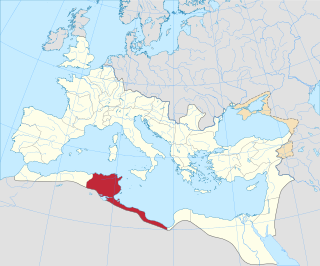
Villamagna of Tripolitania was a Roman era settlement in what was the Roman province of Tripolitania. The town is identifiable with ruins at Henchir-Sidi-Abdein in today's Libya.

The Roman Empire was the post-Roman Republic period of the ancient Roman civilization. Ruled by emperors, it had large territorial holdings around the Mediterranean Sea in Europe, North Africa, the Middle East, and the Caucasus. From the constitutional reforms of Augustus to the military anarchy of the third century, the Empire was a principate ruled from the city of Rome. The Roman Empire was then ruled by multiple emperors and divided in a Western Roman Empire, based in Milan and later Ravenna, and an Eastern Roman Empire, based in Nicomedia and later Constantinople. Rome remained the nominal capital of both parts until 476 AD, when Odoacer deposed Romulus Augustus after capturing Ravenna and the Roman Senate sent the imperial regalia to Constantinople. The fall of the Western Roman Empire to barbarian kings, along with the hellenization of the Eastern Roman Empire into the Byzantine Empire, is conventionally used to mark the end of Ancient Rome and the beginning of the Middle Ages.

The Roman provinces were the lands and people outside of Rome itself that were controlled by the Republic and later the Empire. Each province was ruled by a Roman who was appointed as governor. Although different in many ways, they were similar to the states in Australia or the United States, the regions in the United kingdom or New Zealand, or the prefectures in Japan. Canada refers to some of its territory as provinces.

Tripolitania is a historic region and former province of Libya.
The city was also an ancient episcopal see of the Roman province of Tripolitania . [1] [2] [3] The only known bishop of this diocese is known from antiquity: The Donatist bishop Rogaziano, who took part in the Council of Carthage (411). There was no Catholic bishop from the town mentioned.

An episcopal see is, in the usual meaning of the phrase, the area of a bishop's ecclesiastical jurisdiction.
A bishop is an ordained, consecrated, or appointed member of the Christian clergy who is generally entrusted with a position of authority and oversight.

The word diocese is derived from the Greek term dioikesis (διοίκησις) meaning "administration". Today, when used in an ecclesiastical sense, it refers to the ecclesiastical district under the jurisdiction of a bishop.
Today Villamagna of Tripolitania survives as titular bishop and the current bishop is Giulio Einaudi, former apostolic nuncio. [4] [5]
A titular bishop in various churches is a bishop who is not in charge of a diocese. By definition, a bishop is an "overseer" of a community of the faithful, so when a priest is ordained a bishop, the tradition of the Roman Catholic and Orthodox churches is that he be ordained for a specific place. There are more bishops than there are functioning dioceses. Therefore, a priest appointed not to head a diocese as its diocesan bishop but to be an auxiliary bishop, a papal diplomat, or an official of the Roman Curia is appointed to a titular see.

